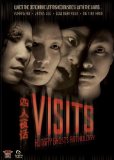Visits – “an anthology of bone-chilling horror”? Well, it has its moments, I will say that. The most effective scenes are the ones that don’t call attention to the scare elements. Scenes that involve one or two little things out of the ordinary that don’t smack you in the face, but actually force a double-take in considering what it was you just saw – that’s when this quartet of horror tales is at its peak. Too many hack horror movies nowadays come pre-packaged for disaster, placing all their little synthetic jumps in the same places they’ve always put them, signifying to the audience, “It’s okay to be scared now.” What happened to films like Bob Clark’s original Black Christmas, where the director lays it all out and lets the audience use its brain to decide what is (and isn’t) scary?
I blame Carpenter’s Halloween, with its simple, creepy musical score, and its stunning musical “stabs.” Grant it, Halloween did this effectively. But that’s because Carpenter knew what the hell he was doing. Unfortunately, the imitators that came after did not.
Visits falls into both camps, and ultimately turns out as a competently cinched mixed-bag of horror. The first tale, “1413,” depicts the fallout of a suicide pact gone south (as if one could ever turn out well). That’s at least what it appears to be on the surface; but the dead half has trouble leaving the surviving half in peace. Psychological mayhem ensues. Next, in “Waiting for Them,” we have a slightly better take on the ghost story that excels at the kind of subtlety mentioned above. In “Nodding Scoop,” a director picks a strange ritual as the subject of his next film, one that gives him his latest star… a visitor with intimate knowledge of what is to come. Last, we have the edgy and voyeuristic “Anybody Home,” told almost entirely from the perspective of apartment building security cameras. Plays like one of those hidden camera shows, but works surprisingly well.
Video
Picture appears in a suitably rendered 1.78:1 widescreen aspect ratio, which means no black bars for those of you with an LCD flat panel. Despite this fact and the film’s youth – only four years – the image can appear a little dim and faded from time to time. Other times the whites bleed a little too heavily, negatively affecting contrast. One such scene – in “1413” – takes place outside on a rooftop. A turquoise cloth appears almost as white as the day sky backdrop. Not a terrible effort, but distracting…
Audio
No power whatsoever! The musical jolts and dialogue exchanges fail to effectively utilize the strength of their 2.0 Mandarin and Cantonese tracks. Characters speak in hushed tones. Background noises range from garbled to non-existent. Thank God for the optional English subtitles, or I would have never known what was going on. Of course, that’s partly my fault – being from Arkansas, I should have brushed up on my Mandarin/Cantonese before viewing.
Special Features
Facet skimps on the extras, providing only a making-of featurette, in which the cast and filmmakers share some anecdotal information in choppy, abbreviated form. It’s mostly filler, uneventful stuff, but still nice to hear from the participants and let them have a little face time. Other than that, we only get trailers for this, and a few other Tidepoint Pictures releases.
Final Thoughts
All four tales – though not always successful at making sense – do demonstrate the abilities of their directors. While the stories often borrow from other Asian horror films, in particular the entire creepy-black-hair-in-the-face genre created by The Ring and its ilk, they’re held together by a fundamental understanding of competent filmmaking and blue-collar performances that don’t astound, but get the job done. I had mixed feelings about the A/V presentation, but felt both (along with the bonus materials) could use an overhaul.






